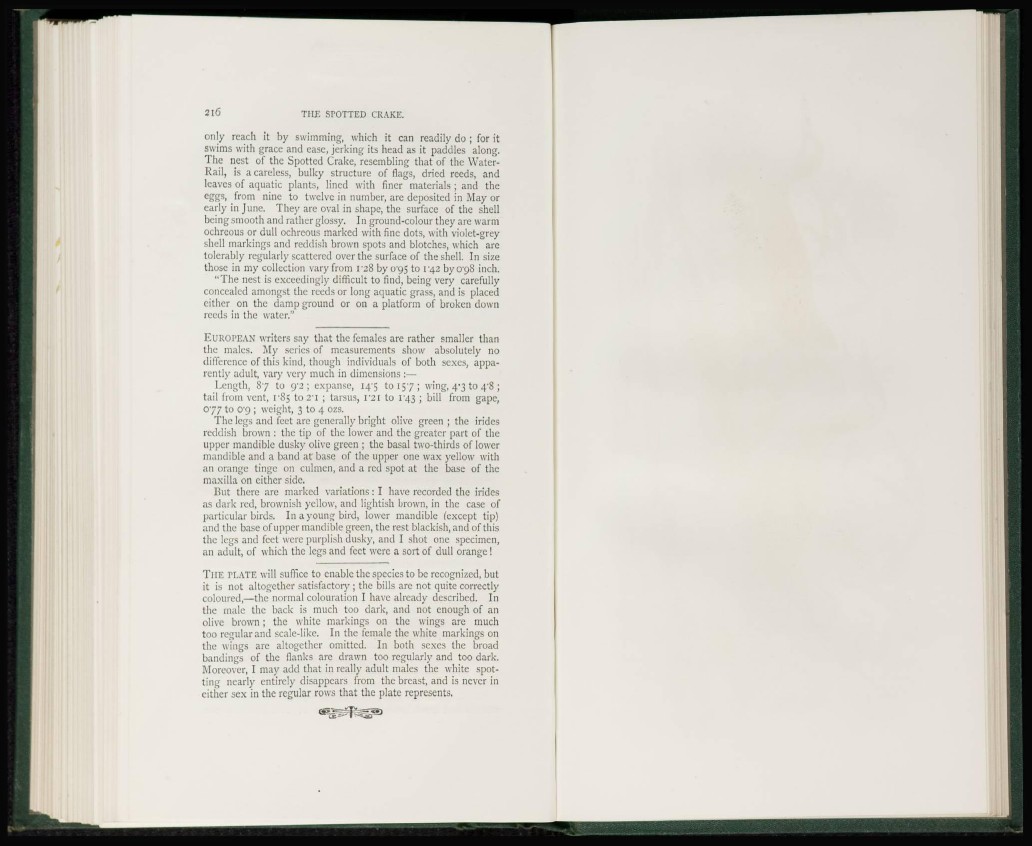
only reach it by swimming, which it can readily do ; for it
swims with grace and ease, jerking its head as it paddles along.
The nest of the Spotted Crake, resembling that of the Water-
Rail, is a careless, bulky structure of flags, dried reeds, and
leaves of aquatic plants, lined with finer materials ; and the
eggs, from nine to twelve in number, are deposited in May or
early in June. They arc oval in shape, the surface of the shell
being smooth and rather glossy. In ground-colour they arc warm
ochrcous or dull ochreous marked with fine dots, with violet-grey
shell markings and reddish brown spots and blotches, which arc
tolerably regularly scattered over the surface of the shell. In size
those in my collection vary from I"28 by o"95 to I"42 byO'pS inch.
"The nest is exceedingly difficult to find, being very carefully
concealed amongst the reeds or long aquatic grass, and is placed
cither on the damp ground or on a platform of broken down
reeds in the water."
EUROPEAN writers say that the females are rather smaller than
the males. My series of measurements show absolutely no
difference of this kind, though individuals of both sexes, apparently
adult, vary very much in dimensions :—
Length, 87 to 9"2 ; expanse, 14^5 to 157; wing, 4-3 to 4"8 ;
tail from vent, 1 -85 t o 2 ' I ; tarsus, I ' 2 I to 1/43 ; bill from gape,
077 to org ; weight, 3 to 4 ozs.
The legs and feet are generally bright olive green ; the hides
reddish brown : the tip of the lower and the greater part of the
upper mandible dusky olive green ; the basal two-thirds of lower
mandible and a band at base of the upper one wax yellow with
an orange tinge on eulmen, and a red spot at the base of the
maxilla on either side.
But there arc marked variations: I have recorded the irides
as dark red, brownish yellow, and lightish brown, in the case of
particular birds. In a young bird, lower mandible (except tip)
and the base of upper mandible green, the rest blackish, and of this
the legs and feet were purplish dusky, and I shot one specimen,
an adult, of which the legs and feet were a sort of dull orange !
THE PLATE will suffice to enable the species to be recognized, but
it is not altogether satisfactory ; the bills arc not quite correctly
coloured,—the normal colouration I have already described. In
the male the back is much too dark, and not enough of an
olive brown ; the white markings on the wings are much
too regular and scale-like. In the female the white markings on
the wings are altogether omitted. In both sexes the broad
bandings of the flanks are drawn too regularly and too dark.
Moreover, I may add that in really adult males the white spotting
nearly entirely disappears from the breast, and is never in
either sex in the regular rows that the plate represents.